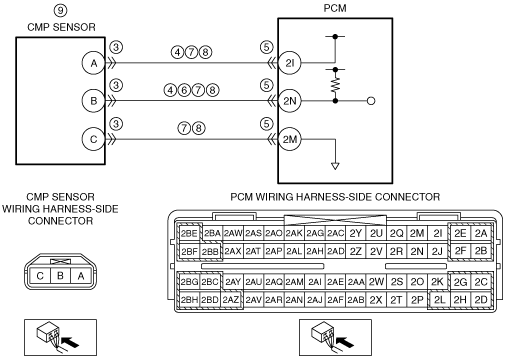|
1
|
VERIFY FREEZE FRAME DATA (MODE 2)/SNAPSHOT DATA HAS BEEN RECORDED
• Has the FREEZE FRAME DATA (Mode 2)/snapshot data been recorded?
|
Yes
|
Go to the next step.
|
|
No
|
Record the FREEZE FRAME DATA (Mode 2)/snapshot data on the repair order, then go to the next step.
|
|
2
|
VERIFY RELATED SERVICE INFORMATION AVAILABILITY
• Verify related Service Information availability.
• Is any related Service Information available?
|
Yes
|
Perform repair or diagnosis according to the available Service Information.
• If the vehicle is not repaired, go to the next step.
|
|
No
|
Go to the next step.
|
|
3
|
INSPECT CMP SENSOR CONNECTOR CONDITION
• Turn the ignition switch off.
• Disconnect the CMP sensor connector.
• Inspect for poor connection (such as damaged/pulled-out pins, corrosion).
• Is there any malfunction?
|
Yes
|
Repair or replace the connector and/or terminals, then go to Step 13.
|
|
No
|
Go to the next step.
|
|
4
|
INSPECT CMP SENSOR CIRCUIT FOR SHORT TO GROUND
• CMP sensor connector is disconnected.
• Inspect for continuity between the following terminals (wiring harness-side) and body ground:
-
― CMP sensor terminal A
― CMP sensor terminal B
• Is there continuity?
|
Yes
|
If the short to ground circuit could be detected:
• Repair or replace the wiring harness for a possible short to ground.
If the short to ground circuit could not be detected:
• Replace the PCM (short to ground in the PCM internal circuit).
Go to Step 13.
|
|
No
|
Go to the next step.
|
|
5
|
INSPECT PCM CONNECTOR CONDITION
• Disconnect the PCM connector.
• Inspect for poor connection (such as damaged/pulled-out pins, corrosion).
• Is there any malfunction?
|
Yes
|
Repair or replace the connector and/or terminals, then go to Step 13.
|
|
No
|
Go to the next step.
|
|
6
|
INSPECT CMP SENSOR SIGNAL CIRCUIT FOR SHORT TO POWER SUPPLY
• CMP sensor and PCM connectors are disconnected.
• Turn the ignition switch to the ON position (engine off).
• Measure the voltage at the CMP sensor terminal B (wiring harness-side).
• Is there any voltage?
|
Yes
|
Repair or replace the wiring harness for a possible short to power supply, then go to Step 13.
|
|
No
|
Go to the next step.
|
|
7
|
INSPECT CMP SENSOR CIRCUITS FOR SHORT TO EACH OTHER
• CMP sensor and PCM connectors are disconnected.
• Turn the ignition switch off.
• Inspect for continuity between CMP sensor terminals A, B and C (wiring harness-side).
• Is there continuity?
|
Yes
|
Repair or replace the wiring harness for a possible short to each other, then go to Step 13.
|
|
No
|
Go to the next step.
|
|
8
|
INSPECT CMP SENSOR CIRCUIT FOR OPEN CIRCUIT
• CMP sensor and PCM connectors are disconnected.
• Inspect for continuity between the following terminals (wiring harness-side):
-
― CMP sensor terminal A—PCM terminal 2I
― CMP sensor terminal B—PCM terminal 2N
― CMP sensor terminal C—PCM terminal 2M
• Is there continuity?
|
Yes
|
Go to the next step.
|
|
No
|
Repair or replace the wiring harness for a possible open circuit, then go to Step 13.
|
|
9
|
INSPECT CMP SENSOR
• Inspect the CMP sensor.
• Is there any malfunction?
|
Yes
|
Replace the CMP sensor, then go to Step 13.
|
|
No
|
Go to the next step.
|
|
10
|
VERIFY VALVE TIMING MECHANISM INSTALLATION
• Verify the valve timing mechanism installation for the following parts:
-
― Timing chain
― Camshaft sprocket lock bolt
― Crankshaft pulley lock bolt
• Is there any malfunction?
|
Yes
|
Reinstall the misinstallation or loose parts correctly, then go to Step 13.
|
|
No
|
Go to the next step.
|
|
11
|
INSPECT STOPPER PIN MECHANISM
• Remove the timing chain.
• Inspect the stopper pin mechanism.
• Is there any malfunction?
|
Yes
|
Replace the variable valve timing actuator, then go to Step 13.
|
|
No
|
Go to the next step.
|
|
12
|
INSPECT ROTOR POSITION
• Remove the variable valve timing actuator.
• Is the rotor at the maximum valve timing advanced position?
|
Yes
|
Replace the variable valve timing actuator, then go to the next step.
|
|
No
|
Variable valve timing mechanism is normal.
-
Note
-
• This DTC is detected as an intermittent concern.
• The intermittent concern might be removed using the cleaning mode of the variable valve timing control function.
Go to the next step.
|
|
13
|
VERIFY DTC TROUBLESHOOTING COMPLETED
• Make sure to reconnect all disconnected connectors.
• Clear the DTC from the PCM memory using the M-MDS.
• Start the engine.
• Access the MAF PID using the M-MDS.
• Run the engine when the MAF PID value is more than 1.43 g/s {0.189 lb/min}.
• Perform the KOER self test.
• Is the same DTC present?
|
Yes
|
Repeat the inspection from Step 1.
• If the malfunction recurs, replace the PCM.
Go to the next step.
|
|
No
|
Go to the next step.
|
|
14
|
VERIFY AFTER REPAIR PROCEDURE
• Perform the “AFTER REPAIR PROCEDURE”.
• Are any DTCs present?
|
Yes
|
Go to the applicable DTC inspection.
|
|
No
|
DTC troubleshooting completed.
|
